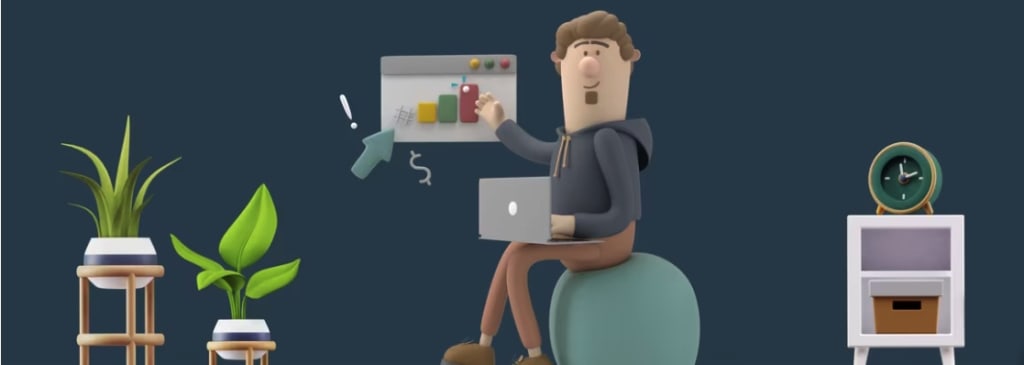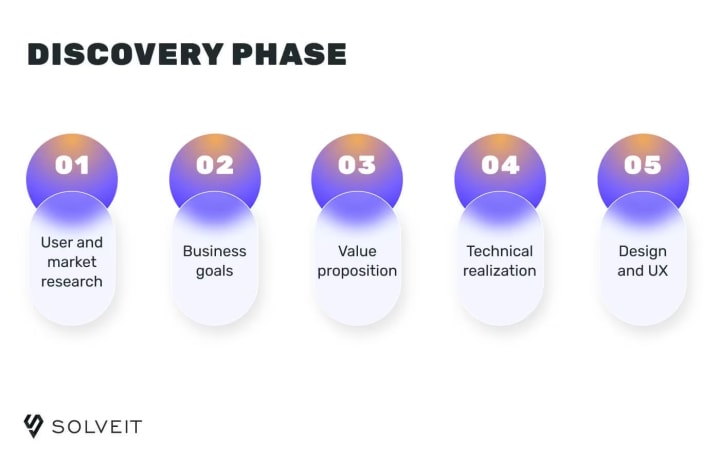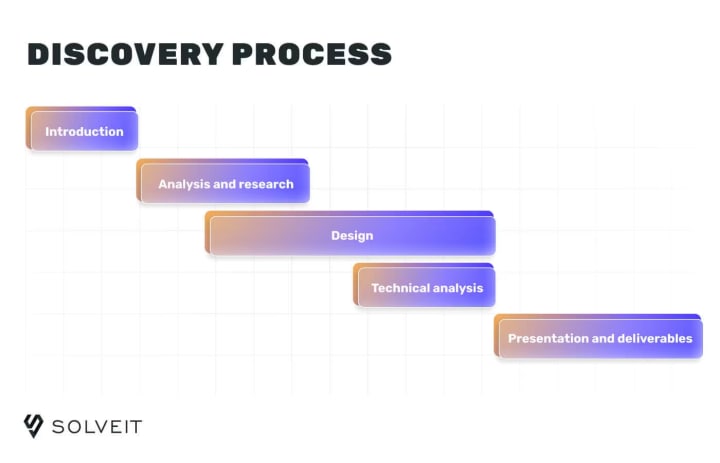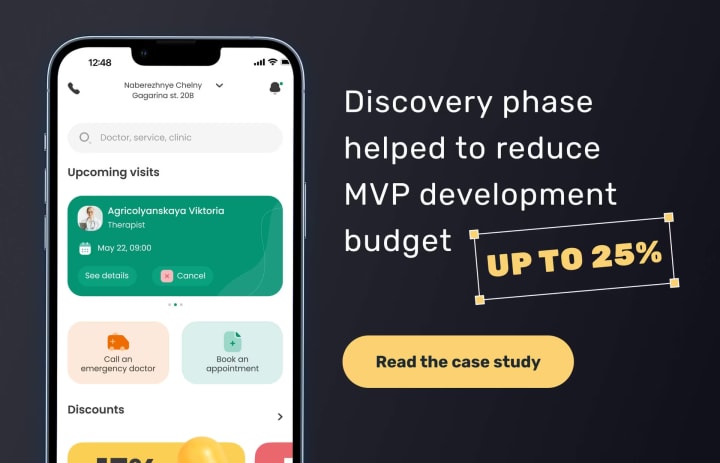Discovery phase of a project: steps, deliverables, cost. Is it so important?
Mobile App Development

According to a recent research from McKinsey, almost a half of software or mobile development projects end up demanding more money as it was initially planned. This is a common problem of most startups and those companies that want to launch an app but don't really have a clear picture about product requirements.
The harsh truth is that the lack of preliminary planning can eventually turn any great project into a sinking Titanic leading to constant budget overruns, broken deadlines, and increased risks of failure. Our practical experience shows that 90% of the time the so-called “discovery phase” works as a very effective solution, especially if done by a team of experts.
In this blog post, we'll talk about the importance of the project discovery phase in the process of product development, its goals, steps, and deliverables.
What is a discovery phase in a project?
Discovery phase is the preliminary stage of a software development project. During this phase, the experts conduct in-depth market research, analyze the client's business goals, create functional and non-functional requirements for the future product.
“I believe that a discovery phase is an integral part of any project: a startup building realizing its unique idea or a software product development for an established business.
Each project should begin with the definition of the needs: whether it is a problem or a potential business opportunity. Not always the solutions requested by stakeholders are the very tools they need to meet their real business needs. The discovery phase is here to determine the most relevant solution for each case.”
— Waleriya Bagnyuk-Yurkantovich, Business Analyst at SolveIt.
This results of the discovery phase in a set of documentation like a detailed description & overview of the whole product development process (product vision, technologies that should be used, integrations, product architecture, etc.). Also, the discovery stage includes creating a design concept, interactive prototype, and roadmap to draw the most clear picture of the final outcome. The main goal of the project discovery phase is to stay as close as possible to client’s expectations and fulfill all product requirements.

Even though most software development companies already have the discovery phase included in their development process most of the time, it’s a simplified version of the actual discovery. In other words, they won’t be focusing much on market research & analysis. And users’ needs will be studied just to a certain extent.
Needless to say, reputable agencies like SolveIt won’t even consider working with clients without a discovery phase. The reason is to avoid the potential risks, downfalls, and mutual misunderstandings which 99% of the time will come up during product development.
What specialists are involved in the discovery phase?
Commonly, a project discovery team consists of 3-5 specialists: Business Analyst, Tech Consultant or Architect, Designer, Project Manager (sometimes, a Business Analyst may take on PM’s tasks), and a certain specialist (like industry expert) needed for a particular project.
Business Analyst collects all the necessary data from a client and market. Subsequently, a Business Analyst will interpret data into actionable insights, functional and non-functional requirements.
Designers use the results of the business analysis to create a design concept to target the audience and build wireframes using user journeys. Designer also creates a working prototype to test user experience prior to product development.
Tech Analysts evaluate the project from the developer’s point of view and analyze the technical part of the project like best tools, platforms, and other effective technical solutions. Technical analysts will propose the infrastructure and development approach the most suitable for your product.
Discovery phase steps
Now, let’s go into more details and talk about how everything works in the discovery phase at every step of the way.

Step 1: Introduction
If a client decides to start collaborating with us, we arrange a preliminary intro call with a Business Analyst. This specialist then gathers initial requirements to understand the idea, the current state of the client’s business, main goals, as well as future product value.
Step 2: Analysis and research
This step of the discovery phase includes the meticulous market research including analysis of industry trends and problems in order to get a general idea about the market state and motivation of the client’s target audience. This step also involves studying and analyzing competitors for having a clear idea how to make a competitive solution that will be capable of winning a decent portion of the market.
Step 3: Design
Designer creates a design concept and builds wireframes or a prototype using user journeys. This ensures that user experience will go smoothly while the client can change the concept any time prior to estimation and development.
Step 4: Technical analysis
Tech architect creates a scope of documents in accordance with all the requirements involved in the project. The clearer and more detailed these requirements are, the better all the process participants understand what the product should look like.
Step 5: Presentation and deliverables
After completing all stages of the discovery phase with all necessary data & insights being initiated in the set of documents, now is the time to meet up with the client. The company arranges a meeting to discuss the details and provide the product vision from the business and technical points of view. If the client accepts the proposal with estimated financial and time investments, the company goes ahead and jumps into the MVP development.
Discovery phase deliverables
Once the required data is collected and thoroughly analyzed, the team is ready to provide the client with a pool of documents required for further development. These documents give a clear understanding of the product’s vision, structure, and functionality of the product. It allows you to review the concept, as well as understand the cost and timing of development.
- Vision and Scope document includes data derived from market research & analysis, numbers, and trends to provide clients with an action plan.
- SRS (Software Requirements and Specification) lists all tech specifications and functionality that are required for upcoming product development.
- ERD diagram which illustrates business objects such as people/roles (e.g. end users), tangible business objects (e.g. product), intangible business objects (e.g. log), etc. Infrastructure diagrams show how these entities relate to each other within the system.
- 3rd parties integration document describes in-details all necessary integrations including costs and additional comments. This document helps the client to decide on what services he really needs to be integrated with the product.
- Design concept describes a future product through images, sketches, written statements which helps a client, designers and developers to stay on track all across the creative methods.
- Prototype - an interactive model that looks and works just like an actual product and proves a concept.
- Proposal - a strategic document with a step-by-step development plan and the estimation time/money for the future workflow.
How long does the project discovery phase last?
Typically, these processes take about 2 to 8 weeks.
The total length of the discovery phase depends on the project complexity and the level of expertise of the company that works on the discovery stage. For instance, if we talk about developing a custom software product for an enterprise to automate in-house processes, the discovery phase in this case may take up to 1,5 month or even longer.
On the other hand, the discovery phase for digital products, which don’t require any complex technologies or integrations, in most cases takes less than a month.
Cost of the discovery phase
Generally, discovery phase cost takes up to 10-40% of the total project budget. A very simple discovery phase may cost about $5,000.
At SolveIt, the cost of a discovery phase starts around $7,500 and varies depending on the product complexity. We propose three tailored packages to various objectives: for startups, to build a product for business, and to develop custom software for business automation. There is also an option to craft and calculate custom project discovery phase.
Why do you need the discovery phase?
Yes, in some cases the project discovery phase may seem time-consuming and resource-intensive. But, at the same time, it works very effectively for determining the project's timeline, budget, final product requirements, and specifications.
Moreover, it often helps to reduce the cost of development because it helps to identify clearly what features have to be in the first MVP and what can be added to the future iterations. For example, a discovery phase performed by SolveIt helped to reduce the cost of medical mobile app development by 25% for one of our clients.

The discovery stage, if it’s been worked through responsibly, becomes a powerful tool that shapes an idea into a detailed and well-structured plan of actions. This plan would even boost chances for any startup to get investments from a third party to proceed with the development.
What are the goals of the discovery process?
- Define business goals, product vision;
- Get market, user understanding;
- Get a detailed product architecture;
- Define technologies that should be used, integrations;
- Reduce development costs and risks;
- Create product roadmap.
What problems you may face if you skip discovery phase?
- An underestimated amount of investments;
- Multiple tweaks in functionality and requirements;
- Unnecessary work;
- Overused budget;
- High risks that the final product won’t even have any high value on the market
Summary
Clients often tend to omit the discovery phase thinking that this stage is unimportant. In reality, when it comes down to practical work, the discovery process works incredibly well for getting the clearest product vision/strategy and obtaining a precise development plan with all necessary specifications already listed in there.
Discovery phase helps to dive into the development workflow with confidence knowing that all risks have been carefully thought through and minimized. Most importantly, the client is 100% sure that all processes connected to product development will stay within the budget and meet deadlines.
About the Creator
Artsem Lazarchuk
SEO specialist at SolveIt.
SolveIt offers a full range of services to get your app to the market: from discovery phase to development, app store launch, and support.






Comments
There are no comments for this story
Be the first to respond and start the conversation.